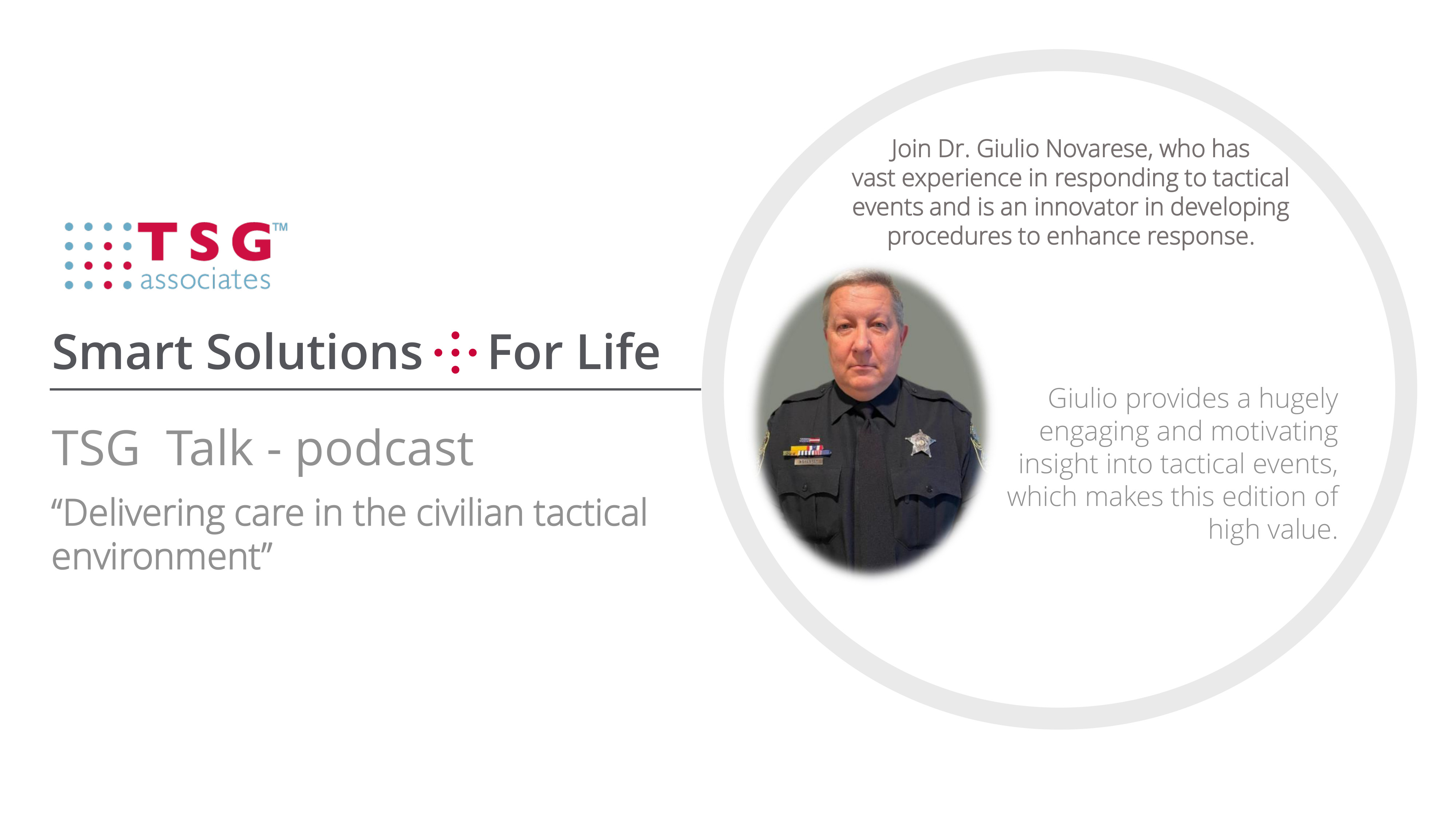


01/06/2022
TSG Talk - Delivering care in the civilian tactical environment
Delivering care in the civilian tactical environment is a responsibility that can involve anyone in civilian pre-hospital care. Often the first responders have limited experience in this area and won’t have a military-based background.
In a recent episode of our podcast, TSGTalk, Senior Partner Colin Smart spoke to Dr Giulio Novarese to explore how unique this area of care can be as well as past experiences and advice for handling care in tactical events.
Having the right mentality
Providing care in a multiple casualty event, including tactical environments, begins with having the right mentality going into the location. The scenario is a rare experience within a high-stress environment which poses challenges that are unlike an everyday trauma situation.
“We take colleagues who predominantly treat and care for vulnerable people every day and we're now putting them into a high-stressed event where there might be more casualties than they've got and there is significant danger as well.”
What are the Tactical Combat Casualty Care Guidelines (TCCC)
The Tactical Combat Casualty Care (TCCC) guidelines are the standard of care for the modern battlefield. They serve as recommendations for care in a wide range of topics such as Care Under Fire (CUF), Tactical Field Care (TFC), and Tactical Evacuation Care (TACEVAC). They were introduced as a collection of information on the causes of death in military events.
“The Tactical Casualty Combat Care came out when Dr John Hagman and Dr Frank Butler started to create this collection of information on why the people were dying on the battlefield. They discovered the first cause of death and it never changed in 200 years was not airway, but it was massive bleeding.”
Being resourceful
When administering care in tactical environments, there is a wide range of injuries that could occur, and some are unfortunately fatal. It’s important therefore to carefully assess the situation and make sure that whoever you provide care for truly needs your resources, as having that focus and awareness can maximise survivors.
“Think what you are doing and save your resources for the guy that may need it. To pack two giant holes in somebody that has no sign of life and waste all your resources, that would be a real shame. So, think use all your protocol, use all your guidelines but don't forget to think. That's always my suggestion. People get blocked, stuck in a protocol.”
Critical skills in a tactical environment
The ‘scoop and run’ is a term given for the practice of transporting injured patients rapidly to a medical facility. When a situation isn’t developing as planned then a ‘scoop and run’ could be incorporated to move the patient to the hospital without further delay, something that Dr Giulio highly recommends.
“We always say scoop and run. I mean, if I can, why not? Why do I have to be obsessed to do some medical manoeuvres that take time to do, when I can just scoop up the guy and go to a place where somebody can do way better than what I can?”
When faced with an injured patient in a tactical environment, you have to justify your decision-making, and not just administer a certain type of care because it’s all you know. The objective is always to minimise the suffering of the patient as quickly as possible, and sometimes that means adopting the ‘do less to save more lives’ approach rather than juggling multiple roles at once which can put more lives at risk.
“Do less, save more lives. Do what you know as fast as you can but if you are deployed somewhere where there is no medical assistance or any kind of advanced surgical team. Well, at that point, there is no do less. At that point, it’s ‘do everything’ because you are the only provider and everybody relies on you.”
What is your essential medical equipment?
Dr Novarese explained how he would choose a tourniquet as his equipment of choice.
“I will always bring a tourniquet. I know we can improvise. But if I have a good piece of equipment and I have multiple casualties I can stick the tourniquet on one guy and go to the other one. So it allows me to do two casualties at once.”
What advice would you give our listeners?
Dr Novarese then gave his advice on enhancing future care.
“Well, safety comes first at the end of the night; you have to go back home to your children and to your family. So I always say, you know, in the tactical situation, you always want to find a way to go back home at the end of the shift. Have awareness of the situation, What's going on around you? Always be prepared and know your kit to the bone; that means just don't bring tonnes of stuff that you don't know well you never use. Reading the instructions when you're working on somebody, isn’t the right thing to do. Know your limits. And if you need help, ask somebody who knows more than you, and they will help you drop your ego and just bring the guy home. That's always the goal.”
Find out more
Click here to listen to the full TSG Talk episode featuring Dr Giulio Novarese, to find out more about life-saving solutions, please call TSG Associates on 01422 557841 or email us at info@tsgassociates.



%202.png)






